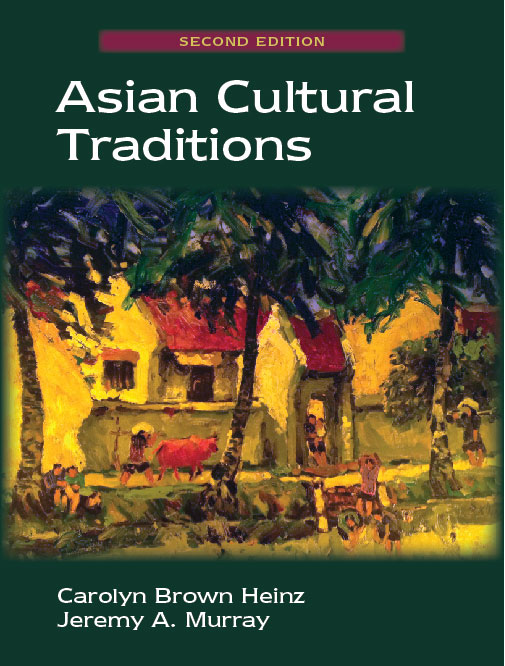“The text has a number of features I like: it brings stories up-to-date, covers so many of the regions and cultures of Asia, and includes Daoism and LGBTQ aspects.” — Ronald Suleski, Suffolk University
“For instructors looking to assign an especially readable and very comprehensive overview of the core cultural traditions of much of Asia, especially East, Southeast, and South Asia, Heinz and Murray’s Asian Cultural Traditions has no competition.” — Steven A. Leibo, The Sage Colleges
“Heinz and Murray have accomplished something quite remarkable here. Lucid, magisterial, subtle, engaging—this book has pretty much everything going for it.” — Don Brenneis, University of California, Santa Cruz

498 pages, $73.95 list
1-4786-3620-3
978-1-4786-3620-5
© 2019
paperback
Instructor's resource materials available here
To obtain a username and password to access these materials, contact comps@waveland.com.
To obtain a username and password to access these materials, contact comps@waveland.com.
eBook availability
Asian Cultural Traditions
Second Edition
The Second Edition of Asian Cultural Traditions expands our understanding of the bewildering diversity that has existed and continues to exist in the cultures of South Asia, East Asia, and Southeast Asia. In a single volume, the authors pull together some of the major cultural strands by which people in Asian societies have organized their collective life and made their lives meaningful. With new sections on Central Asia, Islam, Korea, and Insular Southeast Asia, this first survey of its kind draws on multiple disciplines to contextualize the interplay of culture, historical events, language, and geography to promote better understanding of a realm often misunderstood by Westerners.
The skillful synthesis of a vast amount of information, boxed items featuring popular culture or current events, abundant in-text illustrations, and vivid color plates make Asian Cultural Traditions, 2/E an outstanding introduction to Asian cultures. The Second Edition welcomes the editorial collaboration of Jeremy Murray and is sure to have continued broad classroom appeal.
The skillful synthesis of a vast amount of information, boxed items featuring popular culture or current events, abundant in-text illustrations, and vivid color plates make Asian Cultural Traditions, 2/E an outstanding introduction to Asian cultures. The Second Edition welcomes the editorial collaboration of Jeremy Murray and is sure to have continued broad classroom appeal.
Reactions
Part I: LAND AND LANGUAGE
1. Asia as Cultured Space
The “Great Collision” and Asian Landforms / Monsoon Asia and Rice Adaptations / Early Asians
2. Tongues, Texts, and Scripts
Voices from the Past / Texts / Scripts
Part II: OUTSIDERS
3. Central Asia, Xinjiang, and Tibet
The Silk Roads / Barbarians / Xinjiang and Tibet
4. Tribal People
Self-Governing People and Expansionary States / Ethnic Identity / The Colonial Theory of Ethnicity / Hmong: A Case Study
Part III: SOUTH ASIA
5. India
A Forgotten Past / Brief Outline of Indian History / The Caste System / The Dharma of Women
6. Religions of South Asia
Early Core Ideas / The Hindu-Buddhist Traditions / Islam / Sikhism
Part IV: EAST ASIA
7. China
The Beginnings: Shang, Zhou, and Qin / Emergence of the Confucian Elite (Shenshi) / The Confucian Model for Kinship and Gender
8. Japan
The Yamato State / The China Connection: Asuka, Nara, and Heian Periods / Warrior Culture in Feudal Japan
9. Korea
Religion, Ritual, and Korean Culture / Three Kingdoms Period (378 B.C.E.-935 C.E.) / Koryo Dynasty (918-1392) / Neo-Confucianism in Choson Dynasty (1392-1897) / Korea as Japanese Colony / Challenges of Modern Korea
Part V: SOUTHEAST ASIA
10. Mainland and Insular Southeast Asia
Four Stages of Southeast Asian History / Theravada Buddhism and the Thai State / Buddhism and Popular Religion
11. Insular Southeast Asia
Borneo / Head-Hunting in the Philippines / Romanticized Bali
Part VI: EUROPEAN EMPIRES IN ASIA
12. The Colonial Period
Trade in the Precolonial Period / European Empires in Asia / The Meiji Era
1. Asia as Cultured Space
The “Great Collision” and Asian Landforms / Monsoon Asia and Rice Adaptations / Early Asians
2. Tongues, Texts, and Scripts
Voices from the Past / Texts / Scripts
Part II: OUTSIDERS
3. Central Asia, Xinjiang, and Tibet
The Silk Roads / Barbarians / Xinjiang and Tibet
4. Tribal People
Self-Governing People and Expansionary States / Ethnic Identity / The Colonial Theory of Ethnicity / Hmong: A Case Study
Part III: SOUTH ASIA
5. India
A Forgotten Past / Brief Outline of Indian History / The Caste System / The Dharma of Women
6. Religions of South Asia
Early Core Ideas / The Hindu-Buddhist Traditions / Islam / Sikhism
Part IV: EAST ASIA
7. China
The Beginnings: Shang, Zhou, and Qin / Emergence of the Confucian Elite (Shenshi) / The Confucian Model for Kinship and Gender
8. Japan
The Yamato State / The China Connection: Asuka, Nara, and Heian Periods / Warrior Culture in Feudal Japan
9. Korea
Religion, Ritual, and Korean Culture / Three Kingdoms Period (378 B.C.E.-935 C.E.) / Koryo Dynasty (918-1392) / Neo-Confucianism in Choson Dynasty (1392-1897) / Korea as Japanese Colony / Challenges of Modern Korea
Part V: SOUTHEAST ASIA
10. Mainland and Insular Southeast Asia
Four Stages of Southeast Asian History / Theravada Buddhism and the Thai State / Buddhism and Popular Religion
11. Insular Southeast Asia
Borneo / Head-Hunting in the Philippines / Romanticized Bali
Part VI: EUROPEAN EMPIRES IN ASIA
12. The Colonial Period
Trade in the Precolonial Period / European Empires in Asia / The Meiji Era